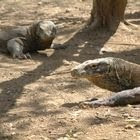World Heritage of Indonesia,Komodo National Park
The following is description about Komodo National Park.S ource Article is UNESCO
Brief Description
Long Description
Historical Description
The following is description about Komodo National Park.S ource Article is UNESCO
Brief Description
These volcanic islands are inhabited by a population of around 5,700 giant lizards, whose appearance and aggressive behaviour have led to them being called 'Komodo dragons'. They exist nowhere else in the world and are of great interest to scientists studying the theory of evolution. The rugged hillsides of dry savannah and pockets of thorny green vegetation contrast starkly with the brilliant white sandy beaches and the blue waters surging over coral.
 |
| Komodo |
Long Description
The generally steep and rugged topography reflects the position of the national park within the active volcanic 'shatter belt' between Australia and the Sunda shelf. Komodo, the largest island, has a topography dominated by a range of rounded hills oriented along a north-south axis at an elevation of 500-600 m. Relief is steepest towards the north-east, notably the peak of Gunung Toda Klea which is precipitous and crowned by deep, rocky and dry gullies.
The coastline is irregular and characterized by numerous bays, beaches and inlets separated by headlands, often with sheer cliffs falling vertically into the sea. To the east, Padar is a small, narrow island the topography of which rises steeply from the surrounding plains to between 200 m and 300 m. Further east, the second largest island in the park, Rinca, is separated from Flores by a narrow strait a few kilometres wide. As with Komodo and Padar, the coastline is generally rugged and rocky although sandy beaches are found in sheltered bays. The mainland components of the park lie in the rugged coastal areas of western Flores, where surface fresh water is more abundant than on the islands of Komodo, Rinca and Padar. The seas around the islands are reported to be among the most productive in the world due to upwelling and a high degree of oxygenation resulting from strong tidal currents which flow through the Sape Straits. Fringing and patch coral reefs are extensive and best developed in the west- and north-facing areas, the most intact being on the north-east coast of Komodo and the south-west coast of Rinca and Padar.
The predominant vegetation type is open grass-woodland savannah, mainly of anthropogenic origin, which covers some 70% of the park. The dominant savannah tree is lontar palm, which occurs individually or in scattered stands. Tropical deciduous (monsoon) forest occurs along the bases of hills and on valley bottoms. The forest is notable, lacking the predominance of Australian derived tree flora found further to the east on Timor. A quasi cloud forest occurs above 500m on pinnacles and ridges. Although covering only small areas on Komodo Island, it harbours a relict flora of many endemic species. Floristically, it is characterized by moss-covered rocks, rattan, bamboo groves and many tree species generally absent at lower elevations. Coastal vegetation includes mangrove forest, which occurs in sheltered bays on Komodo, Padar and Rinca.
The park is best known for the Komodo monitor, the world's largest living lizard. The population is distributed across the islands of Komodo, Rinca and Gili Motong, and in certain coastal regions of western and northern Flores. Favoured habitat is tropical deciduous forest and, to a lesser extent, open savannah. The mammalian fauna is characteristic of the Wallacean zoogeographical zone, with seven terrestrial species recorded including the endemic rat. Other mammals include primates such as crab-eating macaque. Introduced species, such as rusa deer and wild boar, as well as feral domestic animals including horses and water buffalo, form important prey species for the Komodo monitor. Some 72 species of bird have been recorded, including yellow-crested cockatoo, noisy friar bird and common scrubhen.
Upwelling of nutrient-rich water from deeper areas of the archipelago is responsible for the rich reef ecosystem of which only isolated patches remain due to anthropogenic disturbance. In areas of strong currents, the reef substrate consists of an avalanche of coral fragments, with only encrusting or low branching species. Reefs off the north-east of Komodo have high species diversity. The reefs off Gili Lawa Laut are variable. Notable marine mammals include blue whale and sperm whale, which are occasionally observed, as well as 10 species of dolphin and dugong. Marine reptiles include five species of turtle.
It is thought that the islands have long been settled due to their strategic importance and the existence of sheltered anchorages and supplies of fresh water on Komodo and Rinca. The evidence of early settlement is further supported by the recent discovery of Neolithic graves, artefacts and megaliths on Komodo Island.
 |
| Komodo |
The islands of Komodo, Padar, Rinca and Gili Motong and the surrounding waters were declared a 75,OOOha national park on 6 March 1980 (MOF, 1990). This was extended to 219,322ha in 1984 under Ministerial Decree 46/kpts/VI-Sek/1984 to include an expanded marine area and a section of mainland Flores. The island of Padar and part of Rinca were first protected in 1938 when they were established as nature reserves (Auffenburg, 1981) and extended in 1965 when Komodo Island was gazetted under Ministerial Decree No. 66. Komodo was accepted as a biosphere reserve under the Unesco Man and Biosphere Programme in January 1977.

No comments:
Post a Comment